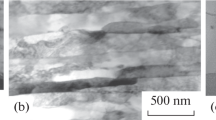Abstract
We study the effect of the implantation of N+ ions on the chemical composition and atomic structure of the surface layers of VT6 titanium alloy. Nitrogen is accumulated in the surface layers up to concentrations of 30 at % or more, and chemical compounds of titanium nitride TiN are formed as phase inclusions. Presumably, this phenomenon is attributed to certain chemical processes, particularly, the chemical reactivity of titanium atoms and their propensity to interact with nitrogen atoms. Although the integral concentration of oxygen in the surface layers decreases under ion bombardment due to sputtering, oxidation of the components of the VT6 titanium alloy is observed in deeper layers. Oxygen from both the natural-oxide layer and the residual atmosphere in the vacuum chamber, penetrating deeper into surface layers during irradiation, is involved in the oxidation of titanium-alloy components. The accumulation of nitrogen, the formation of titanium nitrides, and the oxidation of the components of the VT6 titanium alloy testify to the significant role of chemical processes in the formation of the structural-phase state of the surface layers of the VT6 titanium alloy under N+-implantation conditions.








Similar content being viewed by others
REFERENCES
D. A. Kozlov, B. A. Krit, V. V. Stolyarov, and V. V. Ovchinnikov, Inorg. Mater.: Appl. Res. 3, 216 (2012). https://doi.org/10.1134/S2075113311030142
F. F. Komarov, Ion Implantation in Metals (Energoatomizdat, Moscow, 1990) [in Russian].
J. Jin, Y. Chen, K. Gao, and X. Huang, Appl. Surf. Sci. 305, 93 (2014). https://doi.org/10.1016/j.apsusc.2014.02.174
A. R. Sungatulin, V. P. Sergeev, M. V. Fedorishcheva, and O. V. Sergeev, Izv. Tomsk. Politekh. Univ. 315, 134 (2009).
S. N. Bratushka and L. V. Malikov, Vopr. At. Nauki Tekh., Ser.: Vak., Chist. Mater., Sverkhprovodn., No. 6, 126 (2011).
T. R. Rautray, R. Narayanan, and K.-H. Kim, Prog. Mater. Sci. 56, 1137 (2011). https://doi.org/10.1016/j.pmatsci.2011.03.002
F. Hohl, H. Berndt, P. Mayr, and H.-R. Stock, Surf. Coat. Technol. 74, 765 (1995). https://doi.org/10.1016/0257-8972(95)08274-3
V. L. Vorob’ev, P. V. Bykov, A. A. Kolotov, F. Z. Gilmutdinov, I. K. Averkiev, and V. Ya. Bayankin, Phys. Met. Metallogr. 122, 1213 (2021). https://doi.org/10.1134/S0031918X21120139
Y. Itoh, A. Itoh, H. Azuma, and T. Hioki, Surf. Coat. Technol. 111, 172 (1999). https://doi.org/10.1016/S0257-8972(98)00728-2
L. Thair, U. K. Mudali, S. Rajagopalan, R. Asokamani, and B. Raj, Corros. Sci. 45, 1951 (2003). https://doi.org/10.1016/S0010-938X(03)00027-1
V. C. Nath, D. K. Sood, and R. R. Manory, Surf. Coat. Technol. 49, 510 (1991). https://doi.org/10.1016/0257-8972(91)90109-A
V. L. Vorob’ev, F. Z. Gil’mutdinov, P. V. Bykov, et al., Kim. Fiz. Mezosk. 20, 355 (2018).
V. L. Vorob’ev, F. Z. Gil’mutdinov, P. V. Bykov, et al., Phys. Met. Metallogr. 119, 852 (2018). https://doi.org/10.1134/S0031918X18090144
E. V. Shelekhov and T. A. Sviridova, Met. Sci. Heat Treat. 42, 309 (2000). https://doi.org/10.1007/BF02471306
V. A. Rabinovich and Z. Ya. Khavin, Brief Chemical Handbook, 2nd ed. (Khimiya, Leningrad, 1978) [in Russian].
A. S. Bolgar and V. F. Litvienko Thermodynamic Properties of Nitrides (Naukova Dumka, Kiev, 1980) [in Russian].
NIST XPS Database (2012) NIST. https://srdata.nist.gov/xps/EnergyTypeValSrch.aspx.
V. I. Nefedov, X-Ray Electron Spectroscopy of Chemical Compounds: A Handbook (Khimiya, Moscow, 1984) [in Russian].
J. Kurdi, H. Ardelean, P. Marcus, P. Jonnard, and F. Arefi-Khonsari, Appl. Surf. Sci. 189, 119 (2002). https://doi.org/10.1016/S0169-4332(02)00017-X
H. Ardelean, S. Petit, P. Laurens, P. Marcus, and F. Arefi-Khonsari, Appl. Surf. Sci. 243, 304 (2005). https://doi.org/10.1016/j.apsusc.2004.09.122
J. R. Lindsay, H. Jr. Rose, W. E. Swartz, Jr., P. H. Watts, Jr., and K. A. Rayburn, Appl. Spectroscopy. 27, 1 (1973). https://doi.org/10.1366/000370273774333876
T. Gougousi, D. Barua, E. D. Young, and G. N. Parsons, Chem. Mater. 17, 5093 (2005). https://doi.org/10.1021/cm0510965
Y. Liu, D. Wang, C. Deng, et al., J. Alloys Compd. 628 208 (2015). https://doi.org/10.1016/j.jallcom.2014.12.144
V. L. Vorob’ev, L. V. Dobysheva, A. Yu. Drozdov, et al., J. Electron Spectrosc. Relat. Phenom. 252, 147124 (2021). https://doi.org/10.1016/j.elspec.2021.147124
M. C. Biesinger, LeoW. M. Lau, A. R. Gerson, et al., Appl. Surf. Sci. 257, 887 (2010). https://doi.org/10.1016/j.apsusc.2010.07.086
H. Idriss, Surf. Sci. 712, 121894 (2021). https://doi.org/10.1016/j.susc.2021.121894
ACKNOWLEDGMENTS
The studies were carried out using equipment of the Central Collective Use Center “Center for Physical and Physical-Chemical Methods of Analysis, Study of the Properties and Characteristics of Surfaces, Nanostructures, Materials and Products” of the Udmurt Federal Research Center, Ural Branch, Russian Academy of Sciences.
Funding
The work was supported within the framework of the State Assignment of the Ministry of Science and Higher Education of the Russian Federation, project no. 121030100002-0, and with the support of the Ministry of Science and Higher Education of the Russian Federation under agreement no. 075-15-2021-1351 in terms of research by X-ray photoelectron spectroscopy.
Author information
Authors and Affiliations
Corresponding author
Ethics declarations
The authors declare that they have no conflicts of interest.
Additional information
Translated by O. Zhukova
Rights and permissions
About this article
Cite this article
Vorobyov, V.L., Bykov, P.V., Gilmutdinov, F.Z. et al. Features of the Formation of Surface Layers of VT6 Titanium Alloy under N+ Ion-Implantation Conditions. J. Surf. Investig. 17, 1388–1394 (2023). https://doi.org/10.1134/S1027451023050348
Received:
Revised:
Accepted:
Published:
Issue Date:
DOI: https://doi.org/10.1134/S1027451023050348




